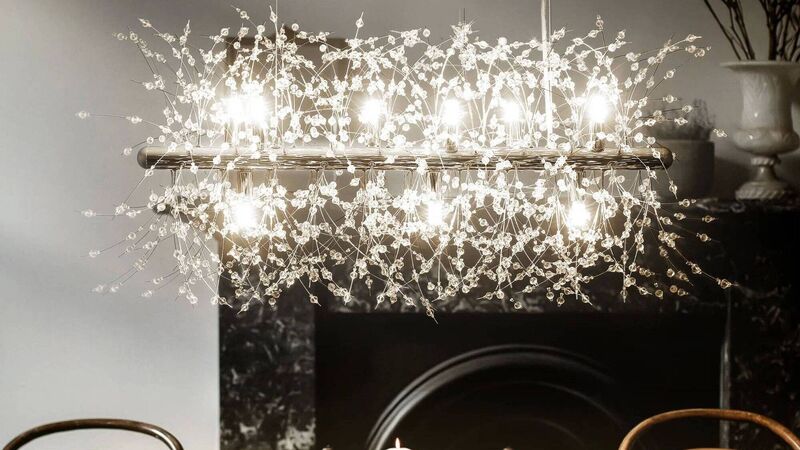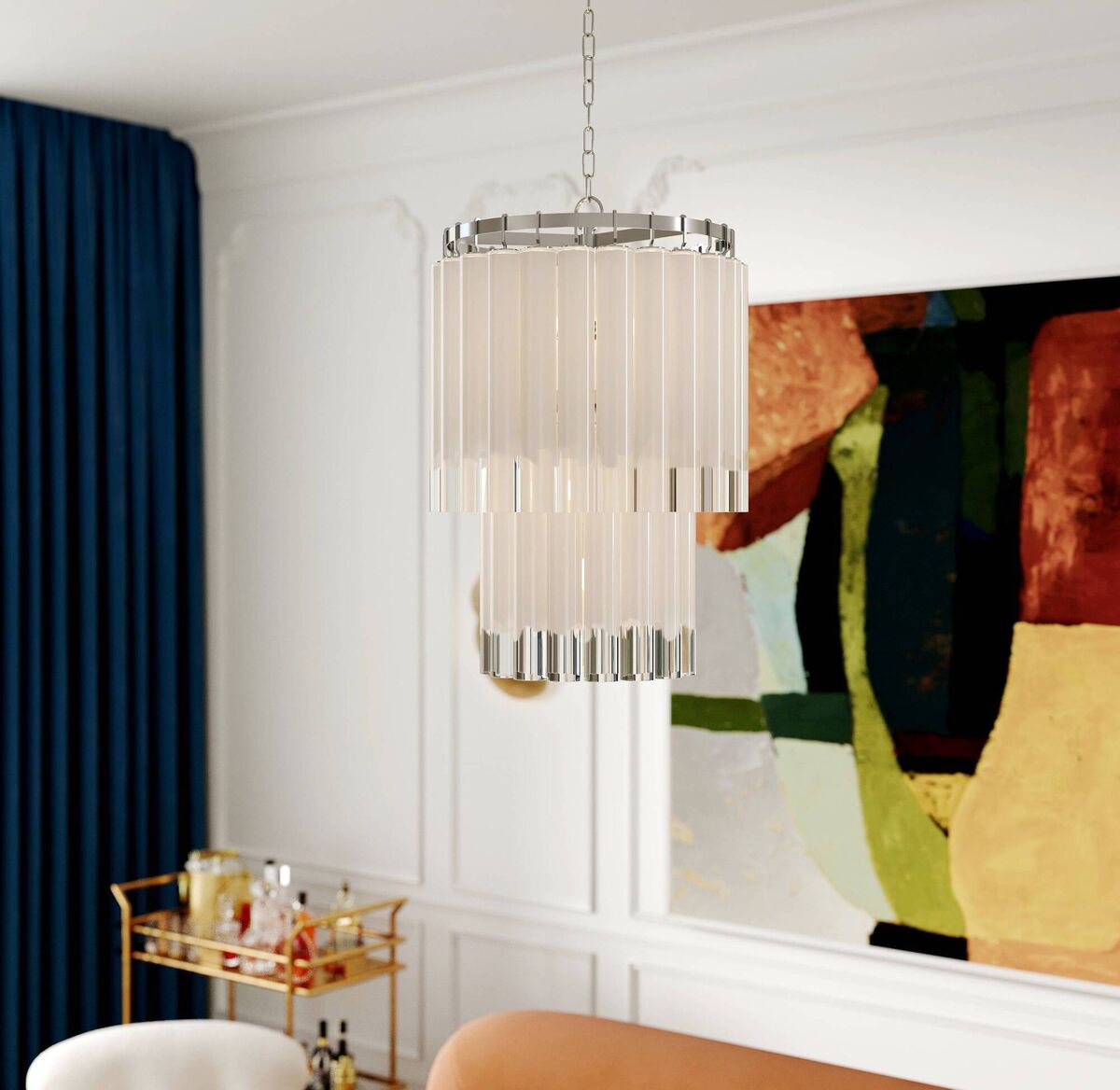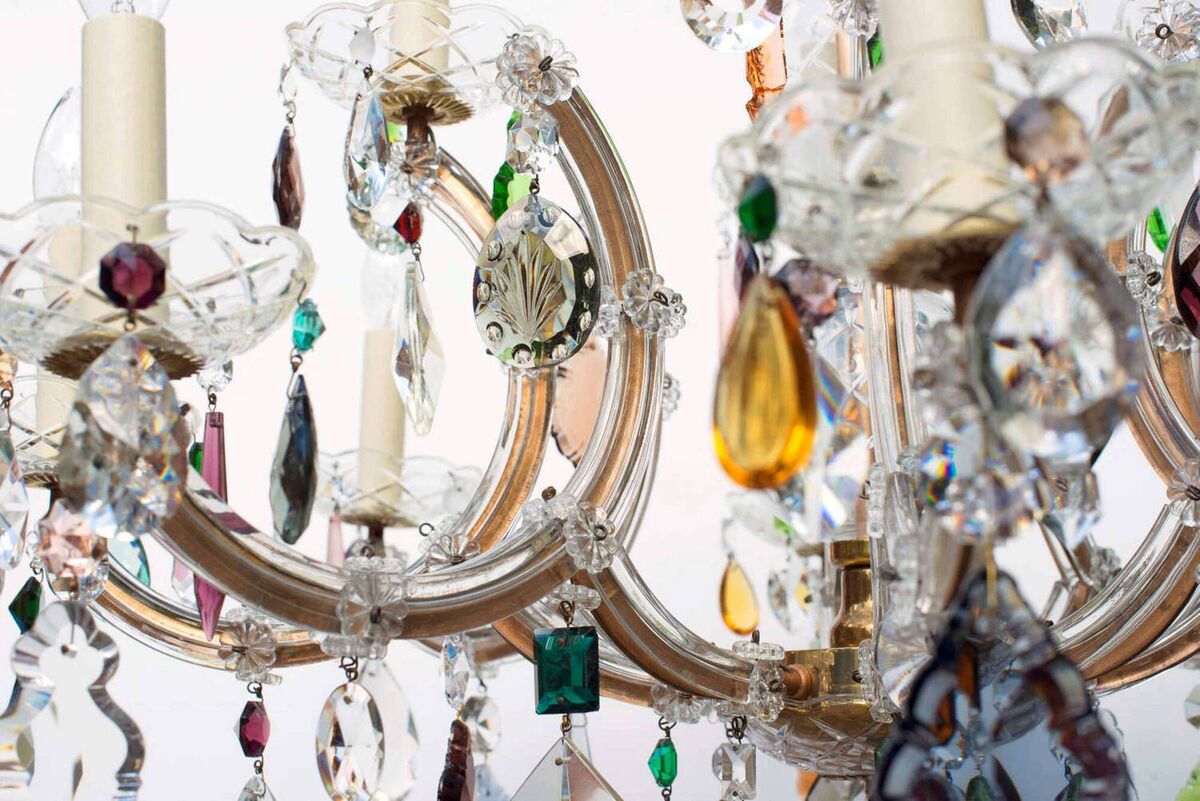Glass chandeliers are trending. Our top picks will add sparkle to your home

Chandelier fire in a modern fitting? This dynamic Dandelion Starburst nine-light piece sets modern materials on a rectangular canopy; Etta Avenue design, from €199.99, Wayfair.
The chandelier has had more interpretations down the centuries than any other lighting piece. Glowing in cut-glass across the painted and plastered ceilings of high society since the 1600s, glass and light provided a supernatural level of magic to a formerly shadowy world. Reflecting and refracting first candlelight and then the brilliance of incandescent electric bulbs, chandeliers were practical as well as gorgeous. They lit a variety of spaces, delivering prismatic light play onto walls, ceilings, and floors. Twisted glass arms, stacked stems, faceted gem-like buttons and glittering glass prisms were combined to create bouquets of blossoms, falling water and icy stalactites.
Acing as gigantic early dimmers, branched chandeliers heaving with watery drops, arabesque leaves, flowers and beaded swags were dropped on heavy chains into the belly of opera houses and ballrooms. They sparkled their way into every royal court, private salon and important building across the World. The Empress of Austria (1717-1780) was even remembered in an enduring style — the Marie Therese.
Hovering in a cloud of light, lead crystal cut to look like more fiddly and expensive rock crystal, followed the shapes of early brass and Dutch and Flemish brass chandeliers. Over time, opulent chandeliers moved into rococo and neoclassical styles. Made in France (lustres), England, Bohemia and Italy, their beauty and prestige proved irresistible for the next three centuries, and chandeliers still dazzle us today. With a nudge towards curated maximalism, cut, blown and pressed glass pendants in classic and contemporary designs are showing strongly for 2026.

So, what makes a chandelier different from a pendant light? There are cross-over forms, but chandeliers always have several light sources (bulbs), usually (but not always) a single flex/chain, and include some sort of branch or tiered support opening the form out. These branches and circular forms are not necessarily tree-like, as with a magnificent French Baroque chandelier, but they are usually indicated in any chandelier. A good chandelier will catch your eye on or off. In daylight, it should have a wonderful silhouette.
Older “empire” styles of chandeliers, still hand-made by world-class makers like Waterford, have classic stem and branch construction. They carry obsolete practical detailing like the glass cups (bobeche) that would have caught dripping candle wax and added more places to hang drops. The iconic tapered art deco-style chandelier is built out of a set of concentric round metal frames. These electrolier dandies with their flashing symmetrical prisms or lush drops are accepted as chandeliers. They have a chic line that can go anywhere, including flush-mounted on a lower ceiling.

In the mid-century, glass prisms in a chandelier were sometimes replaced by moulded glass panels, tubes, globes and various waterfall effects in creative forms from seashells to feathers, flower petals, orbs and even stained glass. Fussy metal and twisted barley glass branches were replaced by metal rods and hooks. So, whether you want a little Downton Abbey elegance in your semi-d or some boutique hotel flash in your flat, there’s a massive choice at every price point, as the creative journey of the chandelier shines on through a 400-year timeline.

Chandeliers can be magnificent or old country charmers. They are not necessarily haughty, super sophisticated fittings. They look equally pleasing in a period rustic kitchen, swaying down to a scrubbed table, as they do as abstract artwork, filling up the yawning space in a modern stairwell. Large lustres and white bubbles, beads and panels in clear and pale opaque glass have the lightweight of a cumulus cloud in the right position. Vintage French chandeliers are particularly versatile, but any clear or coloured glass Marie Therese style is worth a try, even swung low over a bed or kitchen island. Steer away from too much grandeur in a relaxed, informal family space.

The crucial thing, as with any statement pendant, is scale and hanging height — and the rules are very much the same. Some lamps are intended to sit closer to the ceiling, and others will never work without the right length of chain or flex. Undersize a typical antique chandelier and clamp it onto the ceiling rose to clear your head? You’re killing the look, with an uncomfortable up-skirting moment where the light fitting is not seen at its best.
Professional light designers work off the following trusted imperial guide for proportion, but this, of course, can be finessed up or down. Always scale slightly up rather than down. The chandelier’s correct diameter in inches will be roughly equal to the sum of the room’s length and width in feet. So, the room is 15 feet/4.5m by 10 feet/3m, then the diameter of a round chandelier will be around 150 inches/381cm. In a vast open-plan space, you could split the room into two zones before making this calculation and hang two light fittings.
In a very tall room, hallway or corridor with modest floor space, think more about filling the air, as this can be really striking. For height, if you’re 2.4m or lower, consider a flush or semi-flush chandelier, unless you are hanging it over a surface like a dining table. You could take the look to wall lights with decorative lustres. Ensure you include the length of any integral chain, as taken to the last link; this can alter the final look of the light. Adding a dimmer will give you a choice of atmosphere and lighting temperatures. Your chandelier doesn’t have to go in the centre of a ceiling, and slightly off centre might allow you to take it in front of a massive mantel mirror, doubling its presence.

With 2.6m and up, the suspension of the light is up to you, but in open areas, ensure you clear the head of your tallest family member by at least 10cm. For dining or interacting across an island, we need enough clearance to allow easy conversation and to prevent unflattering glare. Seventy centimetres off a table is a base minimum for most designers, and don’t forget you can work along a length of counter or island with a linear design.
Aim to occupy around 30% of the table’s length or diameter with your chandelier — otherwise it may read as visually oppressive. Considering a floor-standing lamp in an awkward corner? Consider a witty chandelier on a dimmer to serve a reading nook. Always include a large pendant as part of the overall layering and balancing against multiple light solutions.
Go big and brave or go home. You have the choice to channel the era and architecture of the room or to harmonise with its current styling. New, old, classic or contemporary — a glass chandelier should be unashamedly fabulous in a larger space — drawing the eye instantly through the rooms. Feeling overwhelmed but still want some cut-glass class? Tease open the shape of the chandelier by trimming back the volume of dingles and dangles (revealing more of the frame) or get completely trendy with a Sputnik set of bars and orbs, or something starry and asymmetric in brilliant LEDs for a stairwell.
If you happen to be in London and want inspiration, sneak into Claridge’s Hotel in London (avoid the cream tea — it’s violently expensive) and stare up into the Dale Chihuly “Celestial Snow Globe” and the forest of modern art deco lighting in the foyer set in flight by Thierry Despont.
Keep an eye on the vintage market and house clearance auctions, which can throw up chandelier choices right through from Georgian to late mid-century modern. If all glass is just too Hyacinth Bouquet for you, explore Venetian-inspired ciocca metal chandeliers with applied flowers and leaves and a light dressing of coloured crystals.
Finally, investigate the rage for deeper, darker colours in classic chandeliers, in particular black. My stand-out favourite is a long, beaded bag empire chandelier, beautifully reinterpreted for modern spaces, and sheer wow.












